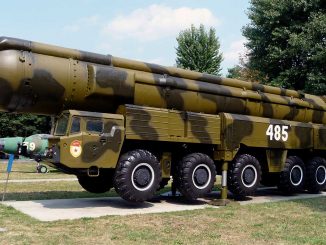We are adjusting to two transitions following the collapse of the former Soviet Union. The first is a change in the targets of our intelligence gathering efforts. The second is a change in the sources that provide us with intelligence gathering systems...
Statement of The Under Secretary of Defense for Acquisition and Technology, Honorable Paul G. Kaminski, Before the House Permanent Select Committee on Intelligence on Enabling Intelligence Technologies for the 21st Century, October 18, 1995. Source : DoD.
Mr. Chairman and members of the committee, let me express my appreciation for the opportunity to share my views on the acquisition of enabling intelligence technologies to support the warfighters’ and national decision makers’ needs in the coming century.
The Department of Defense and the U.S. intelligence community are adjusting to two transitions following the collapse of the former Soviet Union. The first is a change in the targets of our intelligence gathering efforts. The second is a change in the sources that provide us with intelligence gathering systems. The first transition affects what technologies need to be developed and fielded, while the second transition affects how we acquire those systems.
TARGETS TRANSITION
I would like to go back to our Cold War paradigm for a moment and observe how the targets transition has changed our defense planning and intelligence needs. Largely as a result of the efforts of people in this room, we had exquisite information about what was going on in the weapons systems of our principal adversaries during the Cold War. We knew their systems, not only those that were fielded, but those being developed. We had excellent information on the technical characteristics of those systems. In most cases, we had very good information on schedules. We knew when their systems were going to be fielded. In this environment, we could apply an F=MA sort of action-reaction algorithm to define what was required to defeat those systems. We could make a convincing argument to Congress and to the American people on the countering system we needed to develop.
In those days, our intelligence systems were cued to a relatively stable, predictable set of targets for intelligence exploitation. Today, we must cope with an expanded range of ambiguous, unpredictable threats. To support foreign policy decisions and counter the proliferation of weapons of mass destruction, our intelligence systems need to be considerably more robust in collecting multi-source and continuous surveillance data as well as storing, processing, disseminating and managing much larger quantities of information. More importantly, the coming decades promise a quantum shift in the evolution of armed conflict. Our forces are being designed to achieve dominant battlefield awareness and combat superiority through the deployment of fully integrated intelligence systems and technologically superior weapons systems.
You will see a shift in emphasis towards enhancing delivery platforms — ships, aircraft, and tanks — with off board information and highly lethal, extremely accurate weapons. We received an inkling of what combat will look like in the 21st century during Desert Storm and more recently in our support of NATO action in Bosnia. In both cases, unmanned aerial vehicles have demonstrated the ability to provide continuous real-time battlefield surveillance. Moreover, we have employed weapons with great precision — the bomb damage assessment photographs in Bosnia show no pattern of multiple surrounding craters and virtually no collateral damage. We are moving to a situation of one target, one weapon. This has been the promise for the past 20 years, now it is becoming a reality.
We have this precision strike capability today because someone had a vision 20 years ago. Today, we are developing a vision for other major changes in warfare — it is called the Revolution in Military Affairs or RMA. One of the key pillars of the revolution is the need to achieve something called « dominant battlefield awareness. » It means knowing everything going on in a battlefield — everything within an area that can measure up to 200 kilometers by 200 kilometers. The objective is to know where all the enemy forces are. It also means knowing the locations of all the friendly forces as well. This concept is the principal motivation behind the Army’s efforts to « digitize » the battlefield and Force XXI.
But dominant battlefield awareness is much more than knowing the static locations of forces. Commanders will need to know the combat readiness status or « state vector » for each force element. This includes knowing the readiness posture of friendly and enemy forces as well as having a prediction of the resupply needs of each force element. To complete the readiness picture, available logistics support and the need for future support must be propagated from each force element in the field through the whole logistics support system. This is what it means to have « total asset visibility. » To retain our edge on future battlefields, U.S. forces will need to have a shared situational awareness and common understanding of the battlespace. This includes the capability to process the larger volumes of data inherent in multi-, hyper- and ultra-spectral technologies.
Dominant battlefield awareness is critical, but it is not the whole story. It is a necessary condition, but not a sufficient condition to prevail on the 21st century battlefield. What one really needs is something I call « dominant battle cycle time. » This is the ability to turn inside an adversary; to act before the adversary can act. A more stressing objective is to be able to act before the adversary’s battlefield awareness system can see you act. In addition to possessing a dominant battlefield awareness capability, achieving a dominant battle cycle time capability means one also must possess rapid planning tools, strong command and control systems, and superior mobility. Commanders, battle managers and mission planners will need to dramatically compress their timelines to bring the right sensors to bear; to identify targets from the background clutter using automatic target recognition (ATR) technology; to gather near real-time information from a variety of distributed world-wide data bases; to task the appropriate standoff strike platform; to perform bomb damage assessment; and to do so without exposing their intentions, information or information systems to compromise by the adversary.
SOURCES TRANSITION
Over the past 30 years, the evolutionary change in the industrial base that supports the DoD and Intelligence Community is no less dramatic than the changes in the world order since the demise of the Soviet Union. America’s commercial markets have continued to expand. The rapid growth of the commercial industrial sector, driven by a commercial market flourishing quite independently of the government, has reduced the once central role of defense and intelligence spending as a driving force for innovation.
In aggregate terms, commercial industry surpassed the DoD in R&D spending back in 1965. The disparity between the DoD and commercial sector investment in R&D has been growing wider ever since. This difference means that relatively more of this nation’s technological momentum will be based on what’s coming out of essentially commercial enterprises.
The bottom line is that we have no choice but to move from separate industrial sectors for defense and commercial markets to an integrated national industrial base. Leveraging commercial technological advances to create military advantage is critical to ensuring that our equipment remains the most advanced in the world. A tighter linkage with commercial markets can shorten the cycle time for system development and reduce the cost of inserting technological improvements into intelligence systems. The Department of Defense and Intelligence Community cannot afford a 15-year acquisition cycle time when the comparable commercial turnover is every 3-4 years.
The issue is not only cost. The lives of our soldiers, sailors, marines and airmen may depend upon shortened acquisition cycle times as well. In a global market, everyone, including our potential adversaries, will gain increasing access to the same commercial technology base. The military advantage goes to the nation who has the best cycle time to capture technologies that are commercially available, incorporate them in our systems, and get them fielded first.
MARKET TAILORED ACQUISITION
There is little doubt that the commercial marketplace will spearhead many of the key enabling intelligence technologies of the 21st century. Here’s where a dual-use strategy will play a big role. The government’s objective should be to marry the momentum of a vigorous, productive, and competitive commercial industrial infrastructure with the unique technologies and systems integration capabilities provided by our defense and intelligence community contractors.
We are reforming our acquisition processes to remove the barriers preventing us from leveraging the capabilities of commercial industry. I have been in my job for about a year now and it has become obvious to me that our fundamental need is to transform the risk averse culture that has grown up within the Department over the years — to create an environment in which it is sensible for people to begin to take prudent risks, to streamline our program management and reduce our acquisition cycle time. We are systematically eliminating military specifications and standards on existing and new procurements, clearing the way to better access dual-use technologies and commercial products. Successful implementation of a dual-use strategy depends upon the Department’s overall acquisition reform effort.
In some cases, the government is seeking to leverage off the commercial technology base without having the taxpayer make the entire root investment. In other cases, we are pursuing the « dual produce » concept where the government takes advantage of commercial production facilities to manufacture equipment for intelligence systems. Telecommunications is one such technology area. In areas where applicable commercial capability exists, the government must capture what is going on in the commercial sector, apply system engineering expertise, and field superior capability on a reduced acquisition cycle.
Where the capabilities are evolving, the government must seek to influence the establishment of standards and architectures as well as participate in industry led consortia to support the breakthrough developments needed to attract commercial investment capital. My sense is that government participation should often be on a shared investment basis. In cases where a market is not likely to develop within the immediate future, the government must make the root investment and compellingly communicate our needs through the authorization and appropriations processes.
For example, our need for advanced automated continuous speech processors in several languages is immediate, but current businesses and commercial pressures have yet to generate a market for these very advanced systems. This is also evident in high performance computing systems. We need performance in the hundreds of teraflops range (10 raised to the 14th power); but, the super computing industry may be a decade away from realizing such performance levels in the systems it markets. Federally sponsored incentives or direct financial support will need to occur in many of these areas. Another critical area where commercial development may lag is in automation and robotics with special applications to intelligence functions. Automation has not succeeded yet—and is not likely to in the next decade—in yielding significant gains in general problem solving. Thus, the government may have to lead the way in developing automated tools for replicating certain intelligence functions.
ENABLING TECHNOLOGIES
Intelligence superiority rests upon three essential technology areas: collection, processing and dissemination. Providing balanced support to each of these pillars leads to the kind of robust intelligence structure that can provide effective, timely support to national decision makers while providing U.S. forces in the field with dominant battlefield awareness and dominant battle cycle time capabilities.
COLLECTION
As we look to the 21st Century, the most promising intelligence collection technologies will come into being less by technology push than by a growing recognition of the difficult intelligence challenges ahead. These include detecting diverse and highly covert efforts to design, manufacture, and hide nuclear, biological, and chemical weapons and their mobile means of delivery. The new and growing demands of our expanded notion of national security—including counter drug, economic, and environmental monitoring—dictate as well the nation’s compelling need to exploit synoptic collection technologies.
The new threats are not easily discernible by current collection systems, especially for non-state actors. These threats will use largely commercial technology, which is commonly available. The U.S. must, therefore, re-examine assignment of collection between space-borne and other assets, and broaden analysis efforts to provide better insight to threat intentions and capabilities. A major investment is required in the technologies supporting human intelligence (HUMINT) and open source exploitation (such as the Internet and other network sources) to gain information on adversary intentions and capabilities.
We have created the Joint Airborne SIGINT Architecture (JASA) to provide a unified signals intelligence (SIGINT) architecture for all manned and unmanned airborne reconnaissance systems. JASA will be an open architecture that uses a digital approach based to the maximum extent possible on commercial standards. Once implemented, JASA will be able to respond rapidly to changing collection requirements without large scale hardware changes.
We also have initiated programs to explore new uses of Unmanned Aerial Vehicles (UAVs) to provide long dwell synoptic coverage of the battlefield. The Defense Airborne Reconnaissance Office (DARO) is developing two UAV systems, the Joint Tactical UAV system and the Endurance UAV system, to provide the warfighters with flexible, responsive, assured collection of reconnaissance data. These two systems will include common ground stations for control and receipt of sensor data and a mix of vehicles to respond to dynamic and varied environments.
The Joint Tactical UAV system includes the Pioneer vehicle as a fielded interim capability, the Hunter vehicle which is currently in acceptance testing, and potentially a new close-range Maneuver vehicle. The Endurance UAV system includes three vehicle types: the Medium Altitude Endurance UAV, also known as Tier II or Predator; the Low Observable High Altitude Endurance UAV (more commonly known as Tier III minus or Dark Star); and the Conventional High Altitude Endurance UAV (Tier II plus).
Our high end intelligence collection sensors receive limited benefits from commercial investment. Although remote sensing technologies, especially space-based, have recently become important in the search for resource and mineral reserves, the identification of subterranean aquifers, or for long term climatic studies, the technologies being applied to the commercial problems are those that were developed and are already in use by the intelligence community. Those technologies seem to be sufficient for solving the commercial problems. However, there is little indication that private investment will accelerate needed improvements in the current state of the art in the collection arena. This will remain chiefly a government sponsored activity.
Several paths present themselves for investment. Synthetic Aperture Radar (SAR) and Moving Target Indicator (MTI) performance will be enhanced by advances in microelectronics, specifically in the form of low-cost solid state transmit receive modules capable of higher output, greater sensitivity, and more precise frequency and phase control. This will allow detection and observation of smaller targets and resolution of finer detail at night and in all weather conditions. In the imaging area, key technologies for the future will focus on the penetration of camouflage or foliage, the increase in aperture size or proliferation of synthetic aperture systems, and the incorporation of hyper-spectral technologies into operational systems. The Foliage Penetration Radar technology development program is focused on detecting critical mobile targets in shallow hide and camouflage. It is testing an ultra-wideband system that has the ability of penetrating the foliage canopy and detecting objects on the ground due to the low attenuation at VHF and UHF frequencies (200-900 MHz). The challenge is processing the images over very large synthetic apertures (25-45 degrees), removal of man-made interference (communications and television) and target detection in the presence of numerous large clutter signals (tree trunks). In a similar vein, Interferometric Synthetic Aperture Radar (IFSAR) research is focused on the rapid production of current and high resolution terrain data over wide ranging areas from airborne and space-based platforms.
While it is probable that incorporation of unattended collection schemes using artificial intelligence/decision making software to increase the performance of autonomous collection systems will benefit from developments in the commercial robotics industry, it is equally clear that cutting edge sensor research and the incorporation of nascent phenomenology schemes will still rely primarily on government investment.
PROCESSING
It is in the enabling technologies of processing where the United States is poised for revolutionary change in the next decade. Indeed, without changes of such magnitude, the nation will not fully maximize improvements in collection and dissemination technologies. Since the introduction just 25 years ago of the first commercial microprocessor (the Intel 4004), microprocessor performance has increased over 25,000 times. At that rate, the supercomputers of today are the laptops of tomorrow. The advent of small, high performance processors will enable increases in « on-board » processing and limit the rapidly rising demand for bandwidth.
Two areas of enabling technology stand out. The first is the much faster specialized computational power that could result from breakthroughs in optical computing, high-temperature superconductive devices, and improved packaging techniques. Second and related are anticipated improvements in mass data sorting and mass data storage. Much is made of the fact that only a small portion of collected intelligence data are ever usefully translated into actionable information. But there is enormous information value potentially available from processing otherwise banal data by means of mass data processing algorithms. Mass data storage improvements in such areas as holographic storage, for example, portend the capacity to store terabits/day today and more in the years ahead.
However, processing power alone does not have the ability to transform collected data into usable intelligence. As processing power increases and storage becomes less expensive, we face the prospect of drowning in data but with little usable intelligence. Other components of the information revolution, principally automated data processing paired with knowledge based and intelligent software, are required to provide the connection between raw collected data and militarily useful information. Another promising technique may be nested storage of compressed data in relational data bases. This approach permits decision makers, planners and analysts to have ready access to low resolution compressed data on a routine basis while preserving access to high resolution data when the need arises. Many information intensive commercial enterprises, like the Cable News Network, are actively considering this approach in their strategic plans for next generation information management systems.
Advances in knowledge-based systems, machine learning, and information integration technology promise to dramatically improve the analysts’ ability to monitor vast amounts of information. Steady progress in language understanding technology is creating the capability for computers to analyze, prioritize, and selectively route messages, news reports, and documents to interested analysts. Progress in creating larger and more comprehensive knowledge-bases is dramatically improving our ability to analyze information events and infer the meaning of those events. Machine learning and data mining technologies are enabling the capability to discover hidden correlations and relationships in masses of seemingly unrelated data, making it possible to analyze, correlate, and extract information from massive collections of open source or gathered material.
The need for highly specialized processing permeates the intelligence system, from special purpose front-end processors to high performance computing to analyst tools. For example, the Semi-Automated IMINT Processing (SAIP) Advanced Concept Technology Demonstration (ACTD) is developing and integrating state-of-the-art synthetic aperture radar (SAR) image analysis algorithms and human computer interfaces into a workstation-like environment, significantly increasing the productivity of today’s Image Analyst. This can enable a decreasing analyst population to handle large increases in imagery product allowing expert analysts to process imagery at increased rates and novice analysts to operate at a higher level of accuracy. SAIP will revolutionize image analysis by dividing the workload logically between what computers do best and what humans do best. SAIP reasons in real time about low and medium resolution imagery. It cues the analyst and thus allows processing of much greater volumes of imagery than operationally possible today.
This is a single example of a multitude of tools, including automated target recognition, all-source intelligence correlation, multiple access intelligence nomination, and terrain and feature generation, that have just begun to apply the burgeoning field of knowledge-based and intelligent computing to the intelligence analysis and fusion problems. The further incorporation of advanced algorithms, such as multidimensional fast fourier transform, and of true artificial intelligence systems will continue this progression from simple data manipulation to true information generation. The marriage of these software advances to continued hardware processing advances will form the backbone for improvements in the analysis and fusion of intelligence.
Advances in distributed software architectures and domain applications foster greater ease with which to both disseminate and utilize intelligence data by both the analyst and the operational warfighter. Exploitation of standardized object-oriented commercial off-the-shelf (COTS) software products ensure that disparate system and heterogeneous data bases can be readily integrated and exploited with minimal effort, thereby increasing the efficiency associated with introducing new data sources and processes to the intelligence and operational community. These technologies provide greatly improved opportunity for developing advanced data base query techniques that can autonomously mine for relevant data sources across new and legacy heterogeneous data bases improving both response times and operator workload.
Advanced applications in map-based reasoning, auto registration, distributed collaboration, televideo conferencing, shared white board analysis and standardized visualization software services provide robust mechanisms to bring the intelligence analysts and operational warfighters in a more tightly coupled relationship to better serve the joint real-time crises understanding, planning, and execution processes.
The Joint Surveillance Target Attack Radar System (Joint STARS) provides an example of the application and integration of battle management technologies. I envision three phases of evolution for the Joint STARS program. In the first phase, we were preoccupied with the radar sensor. The current phase is what I call the battle management, command, control and communications (BMC3) phase. In this phase we are weaponizing the Joint STARS E-8 aircraft and ground station modules (GSM) to provide a near real-time wide-area view of the battlefield. Fusion of data takes place both on board the aircraft and in each GSM as the operators view images created by software that combines the Joint STARS radar information with information from other national and airborne systems.
We are about to enter a third phase in which we develop new warfare concepts to exploit the Joint STARS BMC3 capability. Already, each user of Joint STARS information functions as a collection manager, forwarding requests for coverage to the on-board computer software that schedules the viewing area of the Joint STARS radar. The results of the radar collection are then broadcast to all users who know how they want to use the product. In this way, Joint STARS is one of the best examples of closely coupling the user to the collection management, assuring receipt of the information, and permitting the user to manage his or her own intelligence production.
DISSEMINATION
The potential of fused intelligence can only be exploited after it is transferred to planning and operations centers. The exponential increase in processing power carries with it the burden of increasing the demand on already severely strained dissemination resources, especially those that service our maturing strategy of split-based and deployed operations. Here too, significant developments in the commercial sector would appear to hold the key to overcoming these shortfalls.
You need not look much further than your neighbor’s rooftop to grasp the significance that direct broadcast satellites portend for deployed operational forces. New satellite communications services are emerging in the commercial world that will have significant impact on the DoD user community. One way direct or global broadcast services (both data and video), high data rate digital satellite two-way communications, and worldwide satellite-based personal communications services will be crucial not only to meet our normal communications load but also to allow full utilization of the burgeoning intelligence information stream.
Global broadcast service, or GBS, is already in the planning stages. Near term GBS systems will permit the reception of high data rate digital information in satellite dishes as small as 18 inches in diameter at data rates that have previously been enjoyed only by physically connected users. GBS technology could permit the broadcast of fused or even primary intelligence directly to lower echelon users in the area of conflict significantly decreasing the local commander’s battle cycle time.
The technological investment currently being made by the commercial sector in this increasingly competitive and international field is already providing significant leverage for specific DoD applications. Although we foresee some variations being applied to these commercial schemes, such as incorporation of DoD reserved frequencies, robust data security methods, and advanced communication protocols, the capabilities being pioneered by commercial industry will provide the lion’s share of required development in this arena.
So too, the emergence of the new satellite-based personal communications services such as Iridium, INMARSAT-P, Globalstar, and Odyssey, and higher capacity, higher frequency digital satellite networks such as Spaceway and Teledesic, will significantly affect the manner in which satellite communications will be used by distributed or deployed intelligence users. These advanced wireless networks permit orders of magnitude more data to be delivered to users in real time than is currently possible, and they make possible a new level of distributed computing and virtual data base development which is currently restricted to users grouped in local, high bandwidth, optical nets. Further out, breakthroughs in laser communications could increase transmission rates from multi-mega to multi-gigabits of data per second at much less cost, size, and weight than today’s transmission circuits. Overall, these enabling technologies suggest the freeing of tomorrow’s users from the constraints of 19th century wire and 20th century fiber optic means of dissemination.
A high speed global communications network is absolutely essential to the dissemination of intelligence information. Asynchronous Transfer Mode (ATM) and Broadband Integrated Services Digital Network (B-ISDN) are key networking technologies based on the concept of cell switching. They use the entire aggregate bandwidth to provide on demand virtual communications service paths. They are in effect non-blocking systems making optimal use of bandwidth resources across a large and diverse user population, designed to support voice video, and high speed data, making them the first multimedia networking technologies. ATM and B-ISDN are considered enabling since they address the multimedia integration problem over both wide area and local premises, as well as the first real attempt by traditional telecommunications providers and local area network providers to collaborate on a common standard which meets the needs of both worlds.
Synchronous Optical Network (SONET) and Synchronous Digital Hierarchy (SDH) are telecommunications transmission standards which specify a structure and payload for transmission over fiber optics at up to gigabit rates. They constitute the physical transmission medium of choice for ATM. The U.S. version (SONET) utilizes a basic payload based on a STS-1 (51 Mb) building block, while the international version (SDH) utilizes a basic payload based on a STM-1 (155 Mb) building block. Both standards lead to a substantial increase in the bandwidth available (to five Gbps and potentially higher) for moving information from one place to another.
By the end of this decade, it is expected that the first interactive « bandwidth on demand » satellite communications services will be available using next generation Very Small Aperture Terminals (VSATs). These systems are made possible through the availability of Ka and Ku band capacity and constellations deployed to provide coverage where fiber or other terrestrial systems are either impractical or not cost effective. Recent filings with the Federal Communications Commission (FCC) show the potential availability of ATM compatible systems beginning deployment in 1998. The services are expected to offer megabit bi-directional service based on ATM call set up and cell switching.
Wave Division Multiplexing (WDM), wave division switching, wave conversion, and soliton based switching take what heretofore have been viewed as primarily « transmission technologies » and convert them into « switching technologies. » This eliminates the need for intermediate electro-optic conversion within a network resulting in a higher aggregate throughput and savings of network resources. In many high performance applications, we are currently « transmission bound » rather than « compute bound. »
Secure distributed computing and networking technology will be a key enabler for the Intelligence community in the areas of analysis, fusion and dissemination. For the Top Secret and Compartmented sectors of the network, the government will continue to develop the necessary « high grade » security solutions. For the much broader Secret-level (and below) customer community, we will need to rely more on technologies developed in concert with commercial industry under the Department’s Multilevel Information Systems Security Initiative (MISSI). Both the Department of Defense and the Intelligence Community must continue to work a broad spectrum of defensive information warfare issues as we move to the distributed information architectures of the 21st Century.
ORGANIZATIONAL STRUCTURES
The Intelligence Community operates in a layered, vertical hierarchy in which raw information is gathered by sensors at the bottom, is filtered and fused as it moves upward, and emerges as refined, validated intelligence that is disseminated to the customer. Currently, the process has many layers, information moving from bottom to top, with a primary national product (e.g., National Intelligence Estimate) emerging at the top over weeks and months.
The on-going revolution in information technology suggests radical improvements in labor productivity within the Intelligence Community, but only to the extent that organizations are transformed to take advantage of technology’s promises. We have seen much evidence already that information technology fosters networks while diminishing the value of organizational hierarchy. An unwillingness to make organizational change in this direction could risk forgoing at least some of the power of these enabling technologies; even worse, too prolonged a fixation on hierarchy could make us vulnerable to adversaries who more readily adapt to the information revolution.
Although it is difficult to predict the pace and scope of future organizational change, it seems safe to say that network organizations will be favored. In the 21st Century, I look forward to an Intelligence Community process that is much less stratified and segmented; utilizes automated correlation and analysis technologies to push other levels dramatically closer by removing much of the requirement for human interaction; and disseminates intelligence at every level as a primary objective, not an exception. I envision a single intelligence process that has outputs that deliver real-time targeting to weapons systems in seconds (not hours), bomb damage assessment images in minutes (not days), and theater-level mission planning data in hours (not weeks).
Suffice it here to say that the Department of Defense and the Intelligence Community must create an organization and contractual environment conducive to the demands of the new information age. We must redefine security and provide for protecting certain categories of information with new technical and procedural means. Most important, whether in developing specialized hardware and software or in customizing commercial products, the Department of Defense and the Intelligence Community must adapt to the emerging economy of rapid obsolescence, short product cycles, and an ever changing population of small but unique providers.
SUMMARY
Our continued leadership in world affairs depends upon improving our intelligence collection, processing and dissemination capabilities. Today, the threat to U.S. national interests are truly global and less predictable. Our current intelligence systems and structures must be updated to cope with this new world order.
At the same time, the new enabling technologies will be developed largely by the commercial marketplace. For this reason, we in the Department of Defense and the Intelligence Community must take an innovative approach to the acquisition of intelligence systems. In the cases where commercial capabilities are applicable, a dual-use strategy should be pursued to improve the quality and reduce the cost of intelligence systems. Telecommunications is one such area. If we are to have assured and affordable access to the communications technologies needed for future intelligence systems, then we must reach out and exploit technological advances being made in the commercial world.
We are reforming our acquisition processes to reduce the cost of doing business with the Department and to remove the barriers preventing us from leveraging the capabilities of our commercial industry. The Department has a long way to go, but we’re fully engaged and beginning to make visible progress.
In cases where technological breakthroughs are needed first or private investment risk is great, the Department and Intelligence Community must step in through direct financing to develop the leading edge technologies needed. Some sensor technologies will not be commercially viable within the timelines needed for near term intelligence system applications. Some processing technologies need to be « jump started » through government-industry partnerships.
Organizationally, we are headed in the right direction within the Department of Defense — the acquisition workforce is coming down faster than the workload. Integrated product teams (IPTs) are accelerating acquisition decision cycle time through continuous insight, rather than after the fact oversight. We are stressing centralization of the « system of systems » architecture function and maintaining decentralized structures for acquisition execution.
The new challenges for U.S. intelligence systems and processes are driven by the new ways in which 21st Century adversaries will fight. Weapons of mass destruction, offensive information warfare, buried and covert facilities and mobile (« fleeting ») targets exemplify these new challenges. All of these threats exist today, but the 21st Century will present them in a substantially new context, where the weapons are more diverse, more mobile, better concealed, more destructive, and more likely to be used. Improved technology offers one means of addressing these new challenges, but technology by itself will not equip the Intelligence Community to meet 21st Century intelligence requirements. Rather, Intelligence Community process and structure issues will also have to be addressed.
A strong and well-integrated program, tailored to the intelligence needs and commercial realities of today’s world, is critical to the long-term interests of our nation. We have come a long way in restructuring our intelligence systems since the end of the Cold War. We still have more to do.










